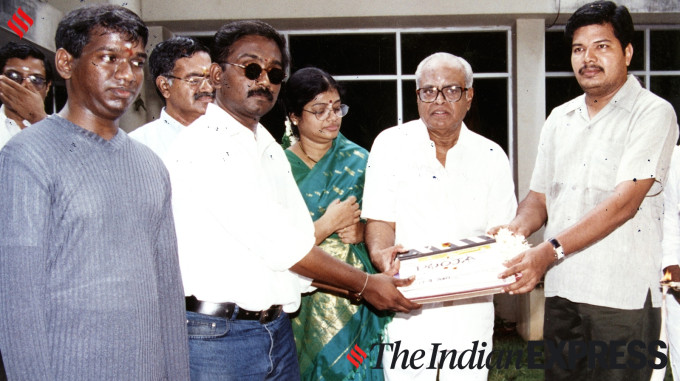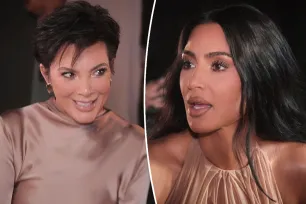The key factor behind Shankar’s successful career is his unwavering determination to dream big. It’s as if Shankar’s default response to the question, “Is your next movie going to be as big as your previous one?” will always be “Athukkum mele (More than that).” By consistently raising the bar in terms of scale, embracing innovation, and leveraging the latest technology, Shankar has remained one of India’s most acclaimed filmmakers for years. Now, he’s hoping to make a grand comeback with the vigilante actioner Indian 2, starring Kamal Haasan, which hits the screens this Friday, six years after his last directorial venture 2.0 (2018).
When discussing Shankar’s movies, one cannot overlook the irony that Shankar Shanmugam did not enter the film industry with the ambition of becoming a filmmaker. No! He wanted to be an actor. He even made appearances in films such as Vasantha Raagam (1986) and Seetha (1990), helmed by SA Chandrasekhar, father of ‘Thalapathy’ Vijay, before eventually joining the director as an assistant. It must not have taken him long to have a change of heart and start dreaming of becoming a filmmaker. In 1993, Shankar stormed the box office with his debut movie, Gentleman.

When it comes to Shankar, one thing that has always puzzled me is how a filmmaker whose works often feature wafer-thin plots and stories, and occasionally share major similarities, has managed to captivate all so effectively for years. Consider this scenario: A man, who has suffered significant losses due to a corrupt system, starts targeting powerful, corrupt individuals, robs them, and uses the proceeds to establish an institute offering free education. Which movie am I referring to? Gentleman or Sivaji: The Boss (2007)? It could be either, as their cores are essentially the same. Yet, both films were blockbusters. It cannot be said that Shankar is a master storyteller or an artiste who has touched the soul of cinema. But that doesn’t mean his films aren’t entertaining for many. One thing he certainly understands — or at least understood, as it’s been long since his last film and we don’t know about his current form — is how to strike the right chord with viewers and do so efficaciously.
In a country like India, where corruption, poverty, and unemployment are unfortunately widespread, the simplest way for a storyteller to connect with the masses is by addressing these pressing issues. Given that our people are overly emotional and sensitive and deeply attached to cinema, a powerful portrayal filled with emotional moments can indeed ache their hearts, wet their eyes. And this is what Shankar has done in many of his films, besides offering a (perhaps false) hope that a saviour, akin to the ‘angry young man’ archetype, will arise from among them to eradicate injustices and build an egalitarian society. This also provides viewers with a cathartic experience. Shankar’s mass entertainers also always feature formidable, ruthless villains who are powerful enough to bring the hero down, ensuring a gripping battle that keeps audiences engaged. Thus, it can be said that his Gentleman, Indian (1996), Mudhalvan/Nayak (1999/2001), Anniyan (2005) and Sivaji (2007) share a common crux, with Enthiran (2010) and 2.0 drawing heavily from the same.
Watch Shankar’s Indian 2 trailer here:
To mask this, Shankar has consistently ensured to keep the audience engaged without giving them a moment to think or lose focus and he employs a variety of techniques for this. This holds true for his romantic films Kadhalan (1994) and Jeans (1998), the coming-of-age musical Boys (2003), and the romantic actioner I (2015) too. From continually throwing conflicts at the central characters and staging lengthy sequences involving extensive movement, which also includes stunts and songs, Shankar keeps viewers occupied. He also gets on board popular comedic actors such as Goundamani, Senthil, Vadivelu, Vivek and Santhanam to fill in the gaps.
Another thing Shankar has cleverly ensured is to collaborate with top-notch technicians, guaranteeing exceptional quality across all aspects of his films. His deep understanding of visual art’s extensive possibilities also enabled him to effectively harness these talents. In Gentleman, while legends B Lenin and VT Vijayan handled the editing, the cinematography was entrusted to Jeeva. For music, he roped in National Award-winning young talent AR Rahman and hired the renowned Vikram Dharma for stunts. Since then, Shankar has adhered to this approach in all his films, ensuring each frame is visually rich and immersive.
 Shankar (centre) with actors Arjun and Madhoo on the sets of Gentleman. (Express archive photo)
Shankar (centre) with actors Arjun and Madhoo on the sets of Gentleman. (Express archive photo)
The small use of computer graphics in Kadhalan, combined with the movie’s larger scale compared to Gentleman, garnered positive responses and contributed to its success. It opened new doors for Shankar and made him see the audiences’ appetite for opulent, Hollywood-style visuals enriched by GFX, beyond typical neighbourhood settings. In the Kamal Haasan-starrer Indian, he elevated the scale significantly while maintaining his trademark strategies. Paired with Kamal’s impactful screen presence and performance, Indian became a big hit and earned Kamal his third National Film Award for Best Actor.
Since then, Shankar has aimed only high. As a director with a 100 per cent success rate, producers faithfully invested in his projects and provided him with the resources needed to realise his vision. In Jeans, he took his love for computer graphics and shooting in exotic locations up by many folds, even going to great lengths such as travelling across multiple countries for the song “Poovukkul” and filming it at various wonders of the world.
Though he returned to his Gentleman/Indian template for Mudhalvan/Nayak, Shankar ventured into new territory with Boys. As the new millennium dawned and technology and the internet began to proliferate, exposing the youth to Western and pop culture, Shankar created the coming-of-age musical featuring six relatively unknown actors. Here too, he boldly experimented with technology and utilised Rahman’s musical expertise extensively. However, its themes and unfiltered portrayal did not resonate widely with audiences, and the film failed to replicate the success of Shankar’s previous ventures.
His subsequent films, Anniyan and Sivaji, adhered to the Gentleman/Indian/Mudhalvan formula. The Vikram-starrer Anniyan centred around a vigilante suffering from Dissociative Identity Disorder (DID). While one of his three personas was a law-abiding, ethically upright person, another was a ruthless vigilante who dealt out death as punishment for all wrongdoings. Sivaji, at the same time, was also a love letter to Rajinikanth and his iconic status, celebrating all aspects that contributed to his superstardom. Predictably, both films became massive hits.
In 2010, Shankar returned with Enthiran, his dream project that had been in discussions since the late ’90s that he initially planned with Kamal Haasan. Here, Shankar unleashed the technology-obsessed kid in him, creating a visual extravaganza that again explored how human beings wield the power to make or break things, no matter how good these things are and the massive destruction that can be caused if these things are machines. With top-tier talent across the cast and crew, Enthiran became India’s most expensive film at the time and shattered numerous box office records.
Following years of producing technically demanding films, Shankar took a break and opted for something simpler. However, even in this venture, he did not create something entirely new and instead remade Rajkumar Hirani’s Aamir Khan-starrer 3 Idiots (2009) in Tamil as Nanban (2012) with Vijay.
 Shankar (second from left) with actors Kamal Hassan, Manisha Koirala and Arjun at the 100th day function of Mudhalvan. (Express archive photo)
Shankar (second from left) with actors Kamal Hassan, Manisha Koirala and Arjun at the 100th day function of Mudhalvan. (Express archive photo)
He then reunited with Vikram and a decade after Anniyan, they arrived with I, which surpassed expectations in terms of its grandeur. Shankar skillfully leveraged Vikram’s talent and willingness to undergo drastic physical transformations and created a visual spectacle that achieved massive success. The film, however, came at a time when regional industries were witnessing a paradigm shift, with stories and the way they are told and visual formats undergoing a revamp. As a result, I did not impress many due to its weak storyline and the problematic aspects of its narrative, especially the portrayal of a person with a disability.
As the sequel to Enthiran, 2.0 arrived with considerable hype. Audiences were eager to see how he would surpass Enthiran. 2.0 was even the most expensive Indian film of its time, starring not only Rajinikanth but also Akshay Kumar. Despite its grand visuals and extensive use of cutting-edge technology, the film suffered from a weak script. Unlike earlier successes, Shankar couldn’t rely on a thin storyline, especially at a time when several well-crafted and technically advanced small films were emerging across different industries. Also, audiences were yet to recover from the Baahubali franchise, which had more dramatic and emotional elements. Nonetheless, 2.0 became one of the highest-grossing Indian films of 2018.
However, the issues with Shankar’s films extend beyond weak scripts and common storylines and often have problematic representations and worship elitism. Since his debut film, Shankar’s fixation with savarna symbols, elitism, and Brahminism has been glaringly apparent. Either his heroes would be Brahmin, like in Gentleman or Anniyan as if they are the “right” ones to clean a society and “purify” it, or they would undoubtedly hail from one of the privileged castes. This portrayal overlooks the social and historical privileges enjoyed by these characters and their families and presents their success as solely due to “hard work,” devoid of systemic advantages.
His obsession with elitism is evident in Enthiran too. While the noble robot Chitti (Rajini) is depicted with fair skin, when reprogrammed into a destructive entity by an evil scientist, Chitti’s complexion darkens, only to revert to fair skin upon returning to earlier mode in the climax. This too aligns with savarna notions and reinforces the subconscious belief among many that skin colour determines a person’s nature, a concept deeply entwined with casteism in the Indian context.
 Shankar (right) with ace Tamil filmmaker K Balchander and others at the launch of an album. (Express archive photo)
Shankar (right) with ace Tamil filmmaker K Balchander and others at the launch of an album. (Express archive photo)
Shankar’s fixation on vigilantism is also glaringly problematic. Even when it comes to vigilantism, the sole punishment his heroes mete out to criminals, regardless of the offence, is death sans a fair trial. Even in other movies addressing social issues, Shankar portrays a bleak view where no available mechanism can rectify the system’s flaws and claims that only a righteous rebel can get the job done.
At the same time, Shankar’s heroines never go beyond being good-looking love interests. Despite significant screen time, none of his female leads are fully developed characters. Even when pivotal to the narrative, they often lack individuality and agency, serving more as pawns in male-dominated storylines or romantic subplots.
As Indian 2 arrives to a more politically aware audience, accustomed to diverse global content, it remains to be seen whether Shankar has adhered to his conventional formula or introduced something afresh. If he has opted for the former, it also remains to be seen if viewers would accept such a movie this time.
Disclaimer: The copyright of this article belongs to the original author. Reposting this article is solely for the purpose of information dissemination and does not constitute any investment advice. If there is any infringement, please contact us immediately. We will make corrections or deletions as necessary. Thank you.







